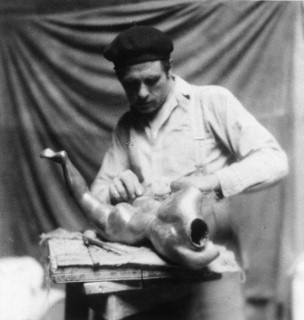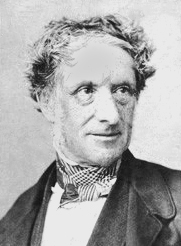Related Research Articles

Kazimir Severinovich Malevich was a Russian avant-garde artist and art theorist, whose pioneering work and writing influenced the development of abstract art in the 20th century. He was born in Kiev, to an ethnic Polish family. His concept of Suprematism sought to develop a form of expression that moved as far as possible from the world of natural forms (objectivity) and subject matter in order to access "the supremacy of pure feeling" and spirituality. Malevich is also sometimes considered to be part of the Ukrainian avant-garde that was shaped by Ukrainian-born artists who worked first in Ukraine and later over a geographical span between Europe and America.

Edward Hodges Baily was a prolific British sculptor responsible for numerous public monuments, portrait busts, statues and exhibition pieces as well as works in silver. He carved friezes for both the Marble Arch and Buckingham Palace in London. His numerous statues of public figures include that of Horatio Nelson on top of Nelson's Column and Charles Grey, 2nd Earl Grey on Grey's Monument in Newcastle upon Tyne. Throughout his career Baily was responsible for creating a number of monuments and memorials for British churches and cathedrals, including several in St Paul's Cathedral.

Sir William Hamo Thornycroft was an English sculptor, responsible for some of London's best-known statues, including the statue of Oliver Cromwell outside the Palace of Westminster. He was a keen student of classical sculpture and was one of the youngest artists to be elected to the Royal Academy, in 1882, the same year the bronze cast of Teucer was purchased for the British nation under the auspices of the Chantrey Bequest.

George Claude Leon Underwood was a British artist, although primarily known as a sculptor, printmaker and painter, he was also an influential teacher and promotor of African art. His travels in Mexico and West Africa had a substantial influence on his art, particularly on the representation of the human figure in his sculptures and paintings. Underwood is best known for his sculptures cast in bronze, carvings in marble, stone and wood and his drawings. His lifetime's work includes a wide range of media and activities, with an expressive and technical mastery. Underwood did not hold modernism and abstraction in art in high regard and this led to critics often ignoring his work until the 1960s when he came to be viewed as an important figure in the development of modern sculpture in Britain.

Alexander Porfyrovych Archipenko was a Ukrainian-American avant-garde artist, sculptor, and graphic artist, active in France and the United States. He was one of the first to apply the principles of Cubism to architecture, analyzing human figure into geometrical forms.

Sir William Reid Dick, was a Scottish sculptor known for his innovative stylisation of form in his monument sculptures and simplicity in his portraits. He became an Associate of the Royal Academy in 1921, and a Royal Academician in 1928. Dick served as president of the Royal Society of British Sculptors from 1933 to 1938. He was knighted by King George V in 1935. He was Sculptor in Ordinary for Scotland to King George VI from 1938 to 1952 then held the post under Queen Elizabeth until his death in 1961.

Sir Richard Westmacott was a British sculptor.

Baron Pietro Carlo Giovanni Battista Marochetti was an Italian-born French sculptor who worked in France, Italy and Britain. He completed many public sculptures, often in a neo-classical style, plus reliefs, memorials and large equestrian monuments in bronze and marble. In 1848, Marochetti settled in England, where he received commissions from Queen Victoria. Marochetti received great recognition during his lifetime, being made a baron in Italy and was awarded the Legion of Honour by the French government.

Benedict William Read, BA, FSA was an English art historian. Usually known as Ben Read, he was the author of numerous books, essays and articles on nineteenth and twentieth century art history, and was one of the most authoritative writers in the second half of the twentieth century on British Victorian sculpture.
Elizabeth Marion Rea was an English sculptor and educationalist.

Ferdinand Victor Blundstone (1882–1951) was a Swiss-born sculptor who worked in England. His father was Charles Blundstone, an India rubber merchant who was born in Manchester, England. He studied at the South London Technical Art School and Royal Academy Schools.
Alfred Turner was an English sculptor notable for several large public monuments. These included statues of Queen Victoria, works in the Fishmonger's Hall in London and several war memorials, both in the Britiah Isles and abroad.
Mapping the Practice and Profession of Sculpture in Britain and Ireland 1851–1951 is an online database of sculptors and their works. It is the result of a three-year research programme, funded by the Arts and Humanities Research Council and the British Academy. The project was a partnership between University of Glasgow, the Victoria and Albert Museum and the Henry Moore Institute, with systems development being carried out by the Humanities Advanced Technology and Information Institute.

Gertrude Alice Meredith Williams, who generally went by the name of Alice Meredith Williams, was a British sculptor, painter, illustrator and stained glass designer.

William Gilbert Foster was a British painter.
Judith Bluck (1936–2011) was a British sculptor known for her large scale public works in a variety of materials but most notably in bronze and brick.
Amanda Simpson FSA, is a British medievalist, author, editor, librarian and art historian. Photographs attributed to her appear in the collection of the Conway Library at the Courtauld Institute of Art, where she worked as Conway Librarian in the 1970s while completing her studies. She completed her PhD at the Courtauld Institute in 1978 on the subject of 14th-century English and Bohemian painting. She became a Fellow of the Society of Antiquaries of London on 5 May 1990.
Terence Frederick Friedman (1940-2013) was an American-born art and architectural historian and museum curator. After his death in Leeds, UK, The Sculpture Journal, in their tribute, defined him as ‘a rare being - a scholar curator working in a regional museum, and an outstanding art historian, educator and collector’. He was also a highly acclaimed author and respected as a leading authority on 18th century ecclesiastical architecture. His book, The Eighteenth-Century Church in Britain, the first substantial study of the subject to appear in over half a century, won the William MB Berger Prize for British Art History in 2012.
Esther Mary Moore was a British artist known for her sculptures, metalwork and jewellery.
Evelyn Ann Silber is an English art historian and an acknowledged specialist on 20th century British sculpture. She is an honorary Professorial Research Fellow at the University of Glasgow and is researching the marketing of modernist art in early 20th century London and the role played by dealers. Having moved to Glasgow in 2001 to assume the role of Director of the Hunterian Museum and Art Gallery, Silber continues to be based there and is an advocate for Glasgow’s cultural heritage, the conservation of the city, and its tourist industry. She is currently the Chair of the Scottish Archaeological Finds Allocation Panel.
References
- ↑ "University of Glasgow - Schools - School of Culture & Creative Arts - Our staff - Ann Compton". www.gla.ac.uk. Retrieved 2020-09-17.
- 1 2 "About Us - Mapping the Practice and Profession of Sculpture in Britain and Ireland 1851-1951". sculpture.gla.ac.uk. Retrieved 2020-09-22.
- 1 2 "Mobilising "Mapping Sculpture in Britain and Ireland, 1851-1951' (Mobilising Mapping)". UK Research and Innovation.
{{cite web}}: CS1 maint: url-status (link) - ↑ "Art UK | About Governance | Panels and boards". artuk.org. Retrieved 2020-09-17.
- ↑ "Sculpture Journal | UK Sculpture and public monuments". PMSA. Archived from the original on 2019-05-19. Retrieved 2020-09-20.
- ↑ "Search Results for Michael Graeme Compton". WHO'S WHO & WHO WAS WHO. Retrieved 2020-09-22.
- ↑ "Michael Compton". The Times . ISSN 0140-0460 . Retrieved 2020-09-21.
- ↑ "Michael Compton | Simon Tait" . Retrieved 2020-09-20.
- ↑ Compton, Susan Paschal (1983). Kazimir Malevich : a study of the painting, 1910-1935 (to which is to be added the printed book: The World Backwards: Russian futurist books, 1912-1916 [London, The British Library, 1978]) (Ph.D. thesis). Courtauld Institute of Art (University of London).
- ↑ "Sculptural Processes Group". The Courtauld Institute of Art. Retrieved 2020-09-22.
- ↑ Compton, Ann (2015-03-01). 'An essentially different kind of rhythm': Rediscovering Henry Moore's Sculpture in Wood. Tate. ISBN 978-1-84976-391-2.
- ↑ "Who made the Conway Library?". Digital Media. 2020-06-30. Archived from the original on 2020-07-03. Retrieved 2020-10-01.
- ↑ Compton, Ann (2004). The Sculpture of Charles Sargeant Jagger. Aldershot: Henry Moore Foundation in association with Lund Humphries. ISBN 978-0853318644.
- ↑ Compton, Ann (2013). Garth Evans Sculpture: Beneath the Skin. London: Philip Wilson Publishers. ISBN 978-1781300046.
- ↑ John Piper and Ann Compton (1998). Painting in a Coloured Light: An Exhibition of Stained Glass and Related Works. Cambridge: Kettle's Yard Gallery. ISBN 978-0907074168.
- ↑ Compton, Ann (1997). Edward Halliday Art for Life 1925-39. Liverpool: Liverpool University Press. ISBN 978-0853239727.
- ↑ Compton, Ann, ed. (1995). Edward Carter Preston 1885-1965: Sculptor, Painter, Medallist. Liverpool: Liverpool University Press. ISBN 978-0853237921.
- ↑ Ann Compton and Garth Evans (2009). Garth Evans: Sculpture from the Sixties. London: Poussin Gallery. ISBN 978-1906350093.
- ↑ Nichols, K., Wade, R., Williams, G., (eds.) (2016). Art Versus Industry?: New perspectives on visual and industrial cultures in nineteenth-century Britain. Manchester: Manchester University Press. pp. Chapter 10. ISBN 978-0-7190-9646-4.
{{cite book}}:|last=has generic name (help)CS1 maint: multiple names: authors list (link) - ↑ Eustace, Katharine; Stoker, Mark; Barnes, Joanna (2018). Sculpting Art History: Essays in Memory of Benedict Read. Liverpool: Liverpool University Press. ISBN 978-1912793006.
{{cite book}}: CS1 maint: multiple names: authors list (link)